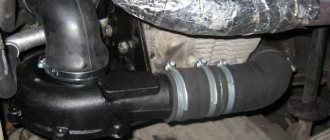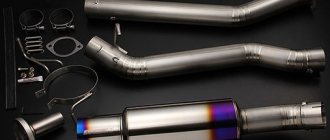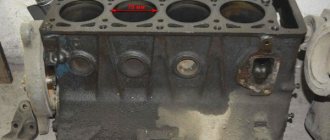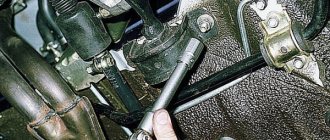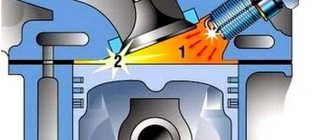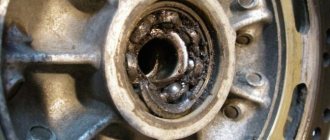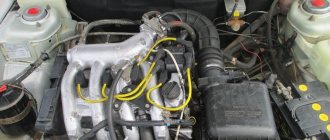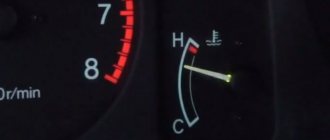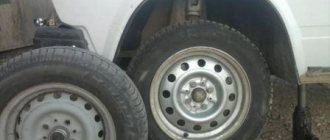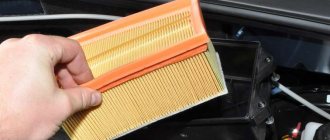At the end of the 70s, the domestic automobile industry needed a front-wheel drive car. None of the engine designs available at that time were suitable for this; AvtoVAZ management entered into an agreement with Porsche to design an engine for a 5-speed manual transmission.
ICE 2108
The VAZ 2108 engine received a volume of 1.3 liters, a transverse arrangement under the hood, a reduced coefficient of resistance to movement and a “swinging candle” type suspension.
Characteristics of ICE 2108
German designers built a small amount of power into the engine, sufficient for a three-door hatchback weighing less than 1 ton. The timing drive again became a belt drive, but the shortcomings of the previous generation 2105 were taken into account. The existing cooling system was ideal for a small engine; replacing it was not practical in terms of cost.
Timing belt drive
ICE 2108 has advanced technical characteristics for its time:
| Manufacturer | VAZ |
| Engine brand | VAZ-2108 |
| Years of production | 1984 – 2004 |
| Volume | 1.3 l |
| Power | 47.2 kW (64 hp) |
| Torque | 95 Nm (3400 rpm) |
| Weight | 127 kg |
| Compression ratio | 9,9 |
| Nutrition | carburetor Solex 1107010 two-chamber emulsion mechanical (cable drive) |
| Motor type | in-line |
| Number of cylinders | 4 |
| Location of the first cylinder | near the timing chain |
| Number of valves on each cylinder | 2 |
| Cylinder head material | aluminum alloy |
| Allowable warpage | manifold gaskets (intake/exhaust) 0.08 mm, cylinder head gasket 0.05 mm |
| Valve seat | width 2 mm, angle 45° |
| Camshaft | one upper cylinder head inside, phase width 232°, exhaust valve advance 42°, intake valve lag 40° |
| Camshaft oil seal | diameters – 40 mm, 56 mm, width 7 mm |
| Cylinder block material | cast iron |
| Cylinder diameter | class A – 76 – 76.01 mm class B – 76.01 – 76.02 mm class C – 76.02 – 76.03 mm class D – 76.03 – 76.04 mm class E – 76.04 – 76.05 mm |
| Pistons and rings | piston made of aluminum alloy, cast iron rings, compression rings - chrome plated on the outside (top) and beveled (bottom) |
| Piston diameter | class A – 75.94 – 75.95 mm class C – 75.96 – 75.97 mm class E – 75.98 – 75.99 mm |
| Gaps | piston/cylinder wall – 0.153 – 0.173 mm (standard) or 0.19 mm (maximum) piston rings – 110 mm relative to the cut plane |
| Upper compression ring | 1.535 – 1.555 mm |
| Lower compression ring | 3.957 – 3.977 mm |
| Oil scraper ring | 2.015 – 2.035 mm |
| Gap between piston groove and ring | 0.04 – 0.07 mm (compression lower) 0.02 – 0.055 mm (oil scraper) 0.03 – 0.06 mm (compression upper) |
| Crankshaft | cast iron, casting |
| Number of main bearings | 5 |
| Gearbox neck diameter | 50.799 – 50.019 mm |
| Main journal gap | 0.1 – 0.5 mm |
| Connecting rod bearings | shaft journal diameter – 47.83 mm liner thickness – 1.448 mm liner width – 28.025 – 28.975 mm |
| Crankshaft oil seals | front – diameters 42 mm, 60 mm, width 7 mm rear – diameters 85 mm, 105 mm, width 10 mm |
| Piston stroke | 71 mm |
| Fuel | AI-92 (A-76 allowed) |
| Environmental standards | Euro 2 |
| Fuel consumption | highway – 7 l/100 km combined cycle 8.2 l/100 km city – 10 l/100 km |
| Oil consumption | maximum 0.7 l/1000 km |
| Engine oil for 2108 | 5W-30 and 15W-40 |
| Engine oil volume | 3.5 l |
| Replacement frequency | every 15,000 km |
| Working temperature | 80° |
| Motor life | declared 120,000 km actual 200,000 km |
| Adjustment of valves | washers |
| Cooling system | forced, antifreeze-A40M, Spectrol |
| Coolant quantity | 7.3 l |
| water pump | polymer impeller, mounted on a block |
| Ignition | non-contact, switch, coil, commutator and distribution sensor |
| Candles for 2108 | Thread M14x1.25 mm, thread length 19 mm, glow number 17 A17DVR |
| Gap between spark plug electrodes | 0.7 – 0.8 mm |
| Timing belt | 111 teeth |
| Cylinder operating order | 1-3-4-2 |
| Air filter | dry with replaceable cardboard cartridge and pre-cleaner, temperature adjustment according to the season |
| Oil filter | recommended Mann W914/2 |
| Flywheel | 129 teeth, 0.62 kg internal hole diameter – 25.67 mm outer diameter – 27.75 mm number of mounting holes – 6 pieces no offsets |
| Flywheel mounting bolts | M10x1.25 mm, length 23.5 mm |
| Valve stem seals | Manufacturers Horse or Corteco |
| Compression | pressure in the cylinders from 11 – 14 bar, pressure difference in individual cylinders within 1 bar |
| Oil temperature | 80°С |
| Thermostat temperature | 80 – 84°С |
| Valve pressure inside the radiator cap | 0.7 – 1 bar |
| Content of harmful products in the exhaust | CH <200%, CO <3% |
| XX speed | 600 – 700 min-1 |
| Tightening force of threaded connections | spark plug – 31 – 39 Nm flywheel – 62 – 87 Nm clutch bolt – 19 – 31 Nm bearing cap – 69 – 84 Nm (main) and 44 – 54 Nm (connecting rod) cylinder head – 4 stages 20 Nm, 71 Nm + 90° + 90° |
The manufacturer recommends using exclusively the given parameters for clearances and tightening forces of threaded connections. It is indicated which oil to pour into the engine and lubrication system.
Transverse motor installation
A distinctive feature of the 2108 internal combustion engine is the fact that, taking into account several repair sizes of the cylinder bore and the piston/ring repair kit, it is classified as a “million-dollar” engine.
Disadvantages and advantages
The 2106 engine has significant disadvantages:
- excess heat is transferred to the well of the piston bottom and fins by steel control plates inside the bosses;
- dynamic loads are reduced due to the displacement of the finger from the axis of symmetry to the right;
- When assembled into an engine, the pistons are mounted with markings in one direction, which increases labor costs and the human factor.
Piston 2106
The internal combustion engine uses a cylinder head from model 2103, a starter 35.3708 and a G221 generator for an engine with a current of 42A. Oil consumption does not exceed 700 g/1000 km. The instruction manual states that it is recommended to add 200 ml less lubricant than the volume of the system as a whole. The markings for which oil to pour are given in the upper table.
Pros and cons
Taking into account the characteristics of the engine, in particular the small volume of 1.3 liters, immediately after launch into production the following shortcomings were revealed:
- leaks through the block cover gasket - the error has not been corrected;
- Solex carburetor - required frequent adjustment of the idle modes;
- pump - intensive wear of polymer blades.
Carburetor for 2108
Since the 2108 engine was the first with a transverse arrangement under the hood of a car, the default exhaust manifold changed its design in comparison with previous generations of AvtoVAZ internal combustion engines. However, the intake manifold remained the same.
Cylinder block. Inspection, troubleshooting and repair of VAZ 2108
Boring and honing of cylinders must be carried out in specialized workshops.
There are two repair sizes of cylinders available.
First repair size: cylinder diameter increased by 0.4 mm.
Second repair size: diameter increased by 0.8 mm.
Even if defects are found in only one cylinder, it is necessary to bore all four cylinders to the same repair size.
There is a special device for measuring cylinders - a bore gauge.
| General information |
| The manufacturer recommends checking the gaps using a plastic calibrated wire as follows: 1). Thoroughly clean beds and covers to remove any oil deposits. 2). Clean the crankshaft journals and bearing shells. 3). Place the crankshaft on the bed of the main bearings with the shells installed. 4). Place pieces of calibrated plastic wire on the crankshaft journals. 5). Install the main bearing caps with the liners installed in them, tighten the cap bolts and tighten to a torque of 82 N·m (8.2 kgf·m), without turning the crankshaft. 6). Remove the main bearing caps. The gap is determined by the degree of flattening of the wire using a scale marked on the wire package. Video about “Cylinder block. Inspection, troubleshooting and repair" for VAZ 2108wear of the piston cylinder liner; check it using a bore gauge. |
What models was the VAZ used in?
The 2108 engine was installed on the VAZ Samara (export) and Sputnik (for the domestic market) models:
- 2108;
- 2109;
- 21099.
ICE 2108 in nine
Deformed internal combustion engines with a volume of 1.1 liters and 1.5 liter engines, the boosting of which was carried out by the VAZ manufacturer at the factory, were installed exclusively on the VAZ 2108 Samara. volumes
Description
The first-born of the eighth family of internal combustion engines, the VAZ-2108, was not a bad engine, but it lacked power. The designers were given the task of creating a new power unit, but with one condition - it was necessary to maintain the overall dimensions of the base VAZ-2108. And it turned out to be doable.
In 1987, a new engine was released - VAZ-21083. In fact, it was a modernized VAZ-2108.
The main difference from the base model was the increase in the diameter of the cylinders to 82 mm (versus 76 mm). This made it possible to increase power to 73 hp. With.
Under the hood – VAZ-21083
Installed on VAZ cars:
- 2108 (1987-2003);
- 2109 (1987-2004);
- 21099 (1990-2004).
Engine modifications can be found on other VAZ models (21083, 21093, 2113, 2114, 2115) produced before 2013.
The cylinder block is cast iron, not lined. The internal surfaces of the cylinders are honed. The peculiarity is the absence of coolant flow between the cylinders. In addition, the manufacturer decided to paint the block blue.
The crankshaft is made of high-strength cast iron. The main and connecting rod journals undergo special high-frequency heat treatment. Mounted on five supports.
The pistons are aluminum, with three rings, two of which are compression, one is oil scraper. The upper rings are chrome plated. A steel plate is cast into the piston bottom to reduce thermal deformation.
Special recesses in the upper part prevent contact with the valves in the event of a broken timing belt.
Pistons VAZ-21083
The cylinder head is cast from aluminum alloy. A camshaft with a valve mechanism is fixed in the upper part. The head differs from the base one in having enlarged channels for supplying the working mixture to the cylinders. In addition, the intake valves have a larger diameter.
The fuel supply system is a carburetor; later versions were equipped with an injector.
The intake manifold was taken from the base model, which was a miscalculation of the designers. Because of this oversight, the quality of the fuel mixture for the souped-up VAZ-21083 was not satisfactory.
The ignition system is contactless.
Otherwise, the engine was identical to the base model.
VAZ specialists note the sensitivity of the engine to the slightest deviations from the requirements for the quality of materials and processing of parts. This note is important to consider when repairing the unit.
To put it simply, using analogues of components and parts will lead to a negative result.
Modifications
If the 2108 engine, according to the contract, was developed by German craftsmen, then its two modifications, 1.1 liters and 1.5 liters, were finalized by domestic designers:
- 21081 – gasoline consumption is reduced to 5.7 liters in the combined cycle, cylinder 76 mm in diameter, piston stroke 60.6 mm;
- 21083 – piston stroke 71 mm, cylinder diameter 82 mm, torque 100 Nm.
Modification 21083
In the first version, the cylinder head was lowered by 5.5 mm, and the maximum speed of the vehicle dropped to 140 km/h. This modification was created for export cars with restrictions on the volume of internal combustion engines of small cars (Belgium and Portugal).
The second modification was recognized as the most successful, allowing for increased power. Factory tuning is always preferable to changing the design yourself; major repairs do not have to be done more often.
Schematic sketch of the VAZ-2112 engine
Detailed diagram of the VAZ-2112 engine.
1 – engine sump. 2 – front crankshaft oil seal. 3 – crankshaft. 4 – crankshaft pulley. 5 – oil pump. 6 – generator drive pulley. 7 – timing belt. 8 – front cover of the timing mechanism drive. 9 – coolant pump pulley (pump). 10 – tension roller. 11 – camshaft toothed pulley. 12 – rear cover of the timing mechanism drive. 13 – camshaft oil seal. 14 – exhaust camshaft. 15 – hydraulic pusher. 16 – valve spring. 17 – valve guide sleeve. 18 – exhaust valve. 19 – receiver. 20 – camshaft bearing cover. 21 – guide pipe. 22 – cylinder head cover. 23 – plastic cover. 24 – spark plug. 25 – intake camshaft. 26 – inlet valve. 27 – cylinder head. 28 – coupling. 29 – fuel rail. 30 – crankcase ventilation hose. 31 – nozzle. 32 – intake manifold. 33 – flywheel. 34 – crankshaft rear oil seal holder. 35 – rear crankshaft oil seal. 36 – cylinder block. 37 – oil dipstick. 38 – piston. 39 – connecting rod. 40 – connecting rod cover. 41 – crankshaft main bearing cover.
Scheduled maintenance procedure
With a transverse arrangement, the internal combustion engine device requires a slightly modified maintenance schedule in comparison with engines of previous generations 2101 - 2106.
| Maintenance object | Time or mileage (whichever comes first) |
| Timing belt | replacement after 100,000 km |
| Battery | 1 year/20000 |
| Valve clearance | 2 years/20000 |
| Crankcase ventilation | 2 years/20000 |
| Belts that drive attachments | 2 years/20000 |
| Fuel line and tank cap | 2 years/40000 |
| Motor oil | 1 year/10000 |
| Oil filter | 1 year/10000 |
| Air filter | 1 – 2 years/40000 |
| Fuel filter | 4 years/40000 |
| Heating/Cooling Fittings and Hoses | 2 years/40000 |
| Coolant | 2 years/60000 |
| Oxygen sensor | 100000 |
| Spark plug | 1 – 2 years/20000 |
| Exhaust manifold | 1 year |
The official manual for the 2108 engine contains a description of the internal combustion engine parameters and recommends the type of oil and coolant.
Block head and timing device
All front-wheel drive cars of the VAZ family, be it 2109, 2110 or 2114, have one cylinder head, common to all cylinders. They are mounted to the block using ten screws. During installation, a metal gasket is placed under it. This gasket is for single use and cannot be reused. There are five camshaft bearings at the top of the cylinder head.
The camshaft of the engine of the VAZ-2109 car has the index 21083. Some engines are equipped with 2110 or 2111 shafts; their design is slightly different from 21083, which allows for an increase in engine power. The shaft is cast from cast iron, there are five supports and eight cams on it that open the valves. It is driven by a toothed belt from the crankshaft pulley. The shafts can be correctly installed relative to each other using the alignment lug on the rear timing belt cover and the marks on the drive gears and flywheel.
Seats are pressed into the cylinder head, as well as valve guides. On the inside of the bushings there are grooves for supplying lubricant; the bushings are closed on top with oil deflector caps.
Typical faults
Since the transmission of rotation is carried out by a toothed belt, if it breaks, the motor is guaranteed to bend the valve. By default, the 2108 engine has the following “diseases”:
- poor valve cover design - periodic replacement of the gasket is required;
- low service life of cooling system components - the pump and hoses should be changed frequently;
- detonation - the problem is solved by the use of high-quality fuel;
- Solex carburetor - replacement with Ozone modifications.
Valve cover
But the 2108 engine is not picky about the quality of the lubricant - it is not so important for the owner which engine oil to use.
Engine tuning
- direct-flow exhaust system - spider circuit 4/2/1 and resonator with banks;
- sports camshaft – gas distribution modes change.
Tuning 2108
Tuning is usually used to add about 10 horsepower. With. by replacing the carburetor with an injector or a direct-flow muffler. There is a time-consuming option to replace the crankshaft with the following crank diameter. The piston stroke increases by 2 mm, but a KShG kit, precise calculation and adjustment of the mechanism are required.
Thus, the 2108 engine uses advanced technologies from the German automobile industry. The weight and dimensions of the engine have been reduced for transverse placement under the hood of a front-wheel drive car. In two versions, 1.1 l and 1.5 l, the modernization was carried out by employees of the manufacturer's plant.
If you have any questions, leave them in the comments below the article. We or our visitors will be happy to answer them
Conversion of carburetor to injector VAZ 2109
First you need to choose a good injection system for the VAZ 2109. Bosch M 1.5.4 is perfect for installation due to its reasonable cost. We installed the injection system without additional upgrades or improvements. This is better than installing an external fuel pump and purchasing additional parts from General Motors.
- air filter box;
- receiver;
- collector;
- gas tank, etc.
Various bolts, clamps and other consumables are not a problem to purchase at any store.
Tank replacement
Before disassembling the carburetor system, wash and dry the new gas tank and install an electric fuel pump. Remember that the arrows on them must match in both places. Make sure that the float of the sensor indicating the fuel level in the gas tank.
Holes for mounting the module and sensor
Next, you need to make a hole in the cylinder block for mounting a bracket designed for an ignition module with a depth of 20 mm, and another one for the knock sensor (16 mm). To do this, drain the antifreeze and remove the radiator along with the bumper.
Sometimes such holes can be made at the factory. If they are not there, then special grooves are provided for the module and sensor. Be careful not to drill through the block! If in doubt, let a master do it for you.
Cooling, generator
Among other things, you need to install a new coolant pipe, and change the temperature sensor in the radiator. After this, you need to drain the oil and remove the pan from there, remove the toothed pulley and belt, and install a special generator damping pulley instead of the standard one.
Then it is necessary to install a new generator, since the new system requires more voltage than usual. Here you can’t get by with just a regular pulley replacement. We need to install a new generator in our VAZ 2109 - this is a must. Otherwise, the generator will simply become unusable.
Wires, connecting devices
- Next, you need to roll out the gasoline - the tank should become lighter.
- Then, before proceeding with further manipulations, remove the battery.
- After this, remove the distributor and fuel pump with all accessories, air filter, carburetor and cables (gas and air supply).
If everything is done, disconnect the ignition wires. They are under the hood. We also remove the fuel pipes, switch, gas tank and vacuum booster hose, which needs to be made longer. It can be taken from one of the previous versions of the VAZ.
Also disassemble the instrument panel. There is a check engine light on it that needs to be connected to a wire. You need to bring the ignition harness out from the engine into the cabin, and connect the wires responsible for the injection harness to the wiring box.
The wires that remain from the carburetor fan relay must be short-circuited together with the fan switch sensor.
We attach all the fuses, relays and controller in the designated places
It is also important to connect the fuel pump to the dashboard. This is necessary for correct fuel level readings (we just remove the standard one)
The block has a head on the side with a plug on which you need to secure the mass of the harness responsible for fuel injection
It is also important not to forget to install the receiver and manifold, as well as the throttle pipe and fuel rail
Installation of the fuel line
What takes the most time and effort is the fuel line, which needs to be laid along the bottom of our VAZ. It is very difficult to run the fuel line under the steering wheel. After all, secure the fuel hoses and filter. There are special bolts for the filter at the bottom of the car. Finally, replace the gas tank and connect the fuel line, and also replace the ignition, sensors and high-voltage wires in their places.
At this stage it is important to securely secure all hoses and ground. If you don't do this, you won't have any problems later.
All that remains is to install the pipe (its hose) and heating for it, an air filter, as well as hoses for crankcase ventilation. After starting the car, and the engine should run smoothly, connect the gas analyzer and DST-2 (diagnostic scanner-tester). It is necessary to reset the errors and adjust the idle mixture.
Replacing a carburetor with an injector for UAZ and Gazelle cars is slightly different. The differences are due to the characteristics of the Gazelle engine.
